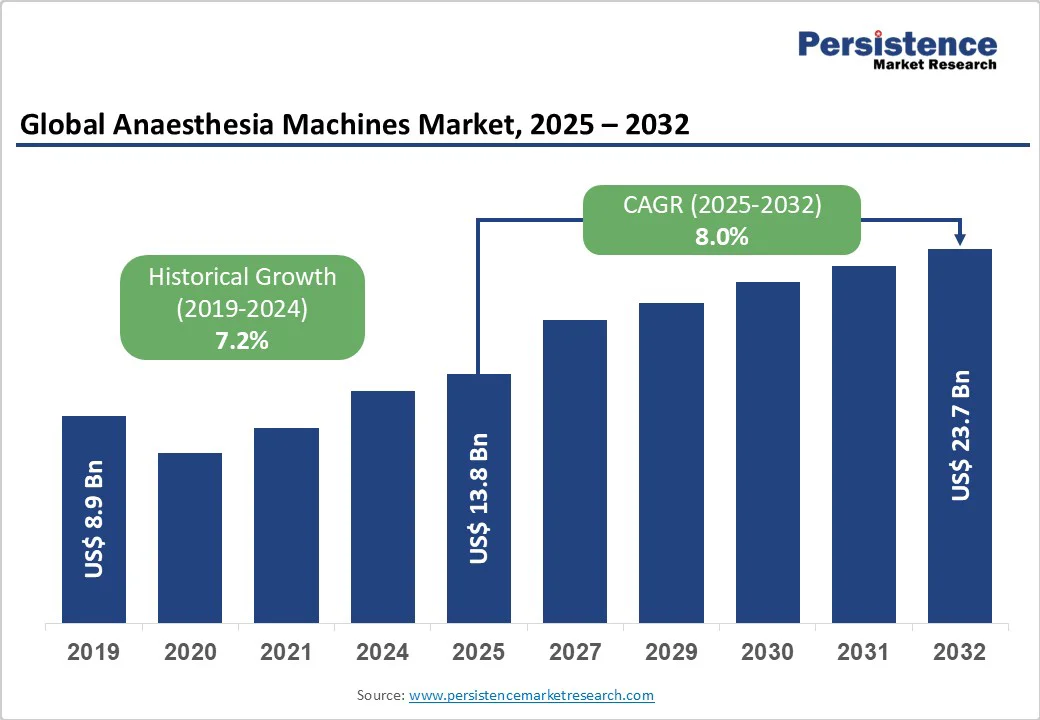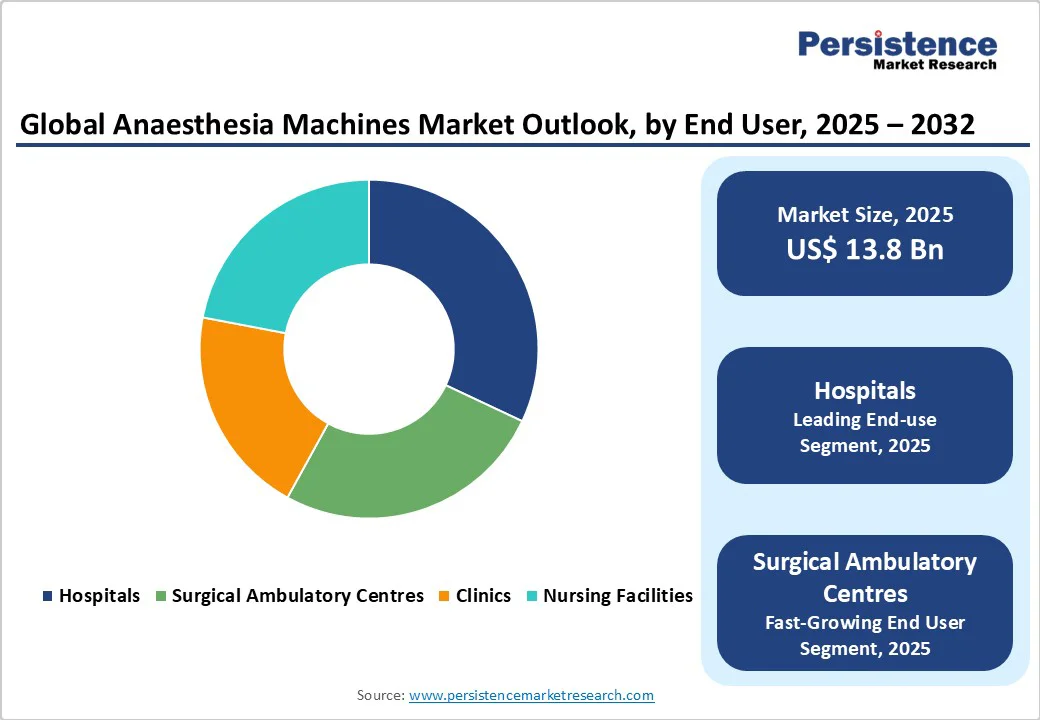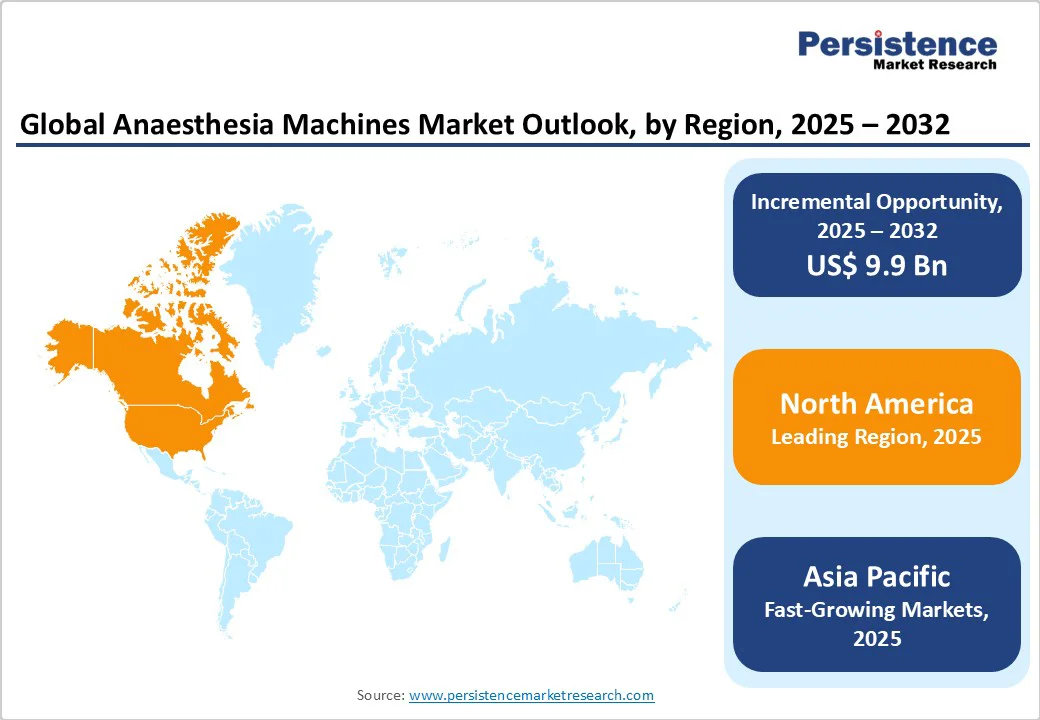ID: PMRREP33701| 200 Pages | 8 Oct 2025 | Format: PDF, Excel, PPT* | Healthcare

The global anesthesia machines market size is likely to be valued at US$13.8 billion in 2025 and reach US$23.7 billion by 2032, growing at a CAGR of 8.0% during the forecast period from 2025 to 2032. The global anaesthesia machines market is experiencing steady growth, driven by increasing surgical procedures, rising prevalence of chronic diseases, and expanding healthcare infrastructure worldwide.
Technological advancements, such as integrated monitoring systems, automated ventilators, and portable anaesthesia machines, are capable of enhancing patient safety and operational efficiency.
| Key Insights | Details |
|---|---|
|
Anaesthesia Machines Market Size (2025E) |
US$13.8 Bn |
|
Market Value Forecast (2032F) |
US$23.7 Mn |
|
Projected Growth (CAGR 2025 to 2032) |
8.0% |
|
Historical Market Growth (CAGR 2019 to 2024) |
7.2% |

The global surge in surgical procedures, both elective and emergency, is a significant driver for the anesthesia machines market. With rising populations, increasing incidences of chronic illnesses, and greater access to healthcare facilities, more patients are undergoing complex surgeries than ever before. Elective procedures, such as orthopedic small joint replacements, cardiac interventions, and cosmetic surgeries, are steadily increasing due to higher patient awareness and disposable income.
Simultaneously, emergency surgeries resulting from accidents, trauma, and acute illnesses require rapid and reliable anesthesia delivery systems. Modern anesthesia machines offer precise dosing, real-time monitoring, and enhanced safety features, ensuring effective management of diverse patient profiles. This growing volume of surgical interventions directly fuels the need for advanced, efficient, and versatile anesthesia equipment across hospitals and surgical centers worldwide.
High initial capital investment remains a significant challenge for the adoption of advanced anesthesia machines, particularly in small clinics, rural hospitals, and emerging economies. These machines often incorporate cutting-edge features such as integrated patient monitoring, automated ventilation modes, and digital interfaces, which significantly raise their purchase cost.
For many smaller healthcare facilities, allocating a substantial portion of their budget to a single machine can strain finances, leading to delayed procurement or reliance on older, less efficient models. This financial barrier not only limits access to modern anesthesia technology for patients in underserved areas but also hampers the overall modernization of surgical infrastructure. As a result, hospitals may prioritize essential infrastructure or staff over upgrading their anesthesia systems, which can slow market growth.
The integration of AI and predictive analytics in anesthesia machines represents a transformative opportunity for modern healthcare. By continuously monitoring patient vitals, such as heart rate, oxygen saturation, and blood pressure, AI algorithms can detect early signs of complications, alerting anesthesiologists in real-time. Predictive models can also forecast potential risks during surgery, enabling clinicians to adjust anesthetic dosages proactively and thereby improve patient safety and reduce post-operative complications.
Beyond clinical benefits, AI-enabled machines can streamline operating room workflows by automating routine monitoring tasks and generating detailed reports for documentation and compliance. Hospitals adopting such smart anesthesia systems can position themselves as technology leaders, enhance patient trust, and reduce overall perioperative costs, making this a high-value innovation in the anesthesia market.
Standalone anesthesia machines lead the market because they are the backbone of modern operating rooms, offering advanced features, integrated monitoring systems, and reliable ventilation support that portable units often lack. Hospitals and surgical centers prefer standalone machines as they can handle complex, prolonged, and high-risk procedures requiring precision and stability. Their ability to integrate with electronic health records, imaging, and advanced patient monitoring systems further enhances workflow efficiency.
Additionally, standalone machines support higher patient throughput, making them cost-effective investments for large facilities. While portable models are gaining traction for ambulatory care and emergency use, standalone machines dominate due to their superior functionality, durability, and suitability for handling diverse surgical demands across multiple specialties.
Hospitals dominate the end-user segment in the anesthesia machines market because they conduct the highest volume of surgeries, including complex and emergency procedures that demand advanced anesthesia support. Unlike clinics or ambulatory centers, hospitals are equipped with specialized operating rooms, intensive care units, and trained anesthesiologists who require multifunctional and reliable machines. Their capacity to invest in technologically sophisticated systems with integrated monitoring, ventilation, and electronic record capabilities further strengthens this dominance.
Hospitals also manage diverse patient groups, ranging from pediatric to geriatric, which require different anesthesia setups, making versatility essential. With continuous upgrades, large budgets, and higher patient throughput, hospitals remain the primary purchasers of standalone and high-performance anesthesia machines, ensuring consistent market leadership.

North America, particularly the United States, leads the anesthesia machines market due to its advanced healthcare infrastructure, high surgical volumes, and rapid adoption of cutting-edge technologies. The region’s hospitals are prioritizing integrated anesthesia workstations with advanced ventilation modes, electronic monitoring, and AI-enabled features to improve patient safety and workflow efficiency. Rising prevalence of chronic diseases, coupled with growing demand for outpatient and ambulatory surgical procedures, further fuels adoption.
Government initiatives supporting healthcare digitization and strict compliance standards drive frequent upgrades of anesthesia equipment. Moreover, the strong presence of global manufacturers and ongoing R&D investments ensures continuous innovation, making North America a hub for smart, portable, and eco-friendly anesthesia machines tailored to both high-acuity and cost-sensitive care settings.
Asia Pacific is emerging as the fastest-growing region in the anesthesia machines market, driven by expanding healthcare infrastructure, rising surgical procedure volumes, and increasing government investment in modern hospitals. Countries such as China, India, and Southeast Asian nations are witnessing the rapid adoption of advanced anesthesia systems to meet the growing burden of chronic diseases and trauma-related surgeries. Medical tourism hubs like Thailand and Singapore are pushing demand for technologically advanced yet cost-efficient machines. Portable and compact anesthesia devices are gaining traction in rural and semi-urban areas, where access to healthcare is limited. Additionally, partnerships between global manufacturers and regional distributors are accelerating innovation, enabling the Asia Pacific to transition from basic equipment use toward integrated, smart anesthesia solutions.

The competitive landscape for anaesthesia machines is shaped by a few dominant firms and many smaller players, all racing to deliver safer, more efficient, and more digitally integrated solutions. Key areas of differentiation include advanced monitoring capabilities, low-flow and gas-saving technologies, portability for ambulatory or remote settings, and AI/automation for precision and workflow optimization. Regulatory rigor, cost of R&D, and after-sales service quality are major barriers to entry.
The global market is projected to be valued at US$ 13.8 Bn in 2025.
The rising number of surgeries worldwide, particularly elective and outpatient procedures, has significantly boosted the demand for anesthesia machines.
The global market is poised to witness a CAGR of 8.0% between 2025 and 2032.
The incorporation of AI and machine learning into anesthesia devices enhances real-time monitoring, predictive analytics, and personalized anesthesia delivery.
DRE Medical, Maquet Getinge Group, GE Healthcare, Penlon, Inc., and others.
| Report Attribute | Details |
|---|---|
|
Historical Data/Actuals |
2019 - 2024 |
|
Forecast Period |
2025 - 2032 |
|
Market Analysis |
Value: US$ Mn |
|
Geographical Coverage |
|
|
Segmental Coverage |
|
|
Competitive Analysis |
|
|
Report Highlights |
|
By Modality
By End-user
By Region
Delivery Timelines
For more information on this report and its delivery timelines please get in touch with our sales team.
About Author